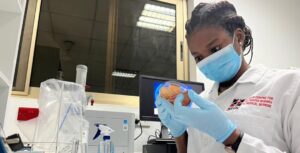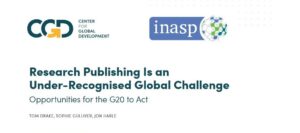
One third of the adolescent girls in Bangladesh miss school during menstruation due to lack of sanitary facilities
Adolescence is an important stage of growth characterized by significant physical, cognitive, and emotional changes. Learning at this stage leads to a healthy or unhealthy adulthood.
A recent research article published in Northern International Medical College Journal and available online at Bangladesh Journals Online (BanglaJOL), supported by INASP, has shown that the majority of Bangladeshi girls are unaware of menstrual hygiene and do not follow standard hygienic procedures during menstruation.
According to the research, 52% of the adolescent girls used cloths instead of sanitary pads; more than one third of the adolescent girls participating in the research said they skipped school on the first two days of menstruation as the schools lacked proper sanitary facilities for girls. Incorrect advice from family members was the main reason behind this. 42.5% of the respondents said they did not use sanitary napkins because family members suggested they use cloths.
The research paper written by Dr. Farhana Salim, Assistant Professor at the Department of Community Medicine, Shaheed Monsur Ali Medical College, Dhaka and Dr. Nasreen Begum, Assistant Professor of Community Medicine at Northern International Medical College, Dhaka revealed that half of the respondent girls in the research got information about menstruation from their family members.
Economic constraints and access were other causes of not using sanitary napkins: 36.7% of the respondents said they did not use sanitary napkins because it was too costly; 8.8% did not use sanitary napkins because they were not available in their area.
As a result, the girls suffered major health problems due to poor sanitary practices during menstruation, and also lost significant numbers of school hours due to poor hygiene management during menstruation.
Poor facilities in school were the main causes for skipping the school. Only 11% of the schools had separate toilets for girls with water facilities, and only 3% of the schools had facilities to dispose of sanitary napkins.
Not surprisingly, even among the girls using sanitary napkins, the majority of them (68.7%) could not change napkins at school due to lack of privacy and proper sanitary facilities; 45% complained about lack of water.
Poor menstrual hygienic practices were found despite good knowledge among girls about issues like minimum age at marriage (18 years, 85.8%), minimum age of child birth (20 years, 89%) and the need for extra nutrition during pregnancy (99%). Implementation of school health programmes for adolescents should emphasize menstrual hygiene management.
In parallel, the education ministry of Bangladesh recently issued a circular asking schools to improve and maintain the sanitation of school toilets.
“The circular emphasizes the menstrual health and hygiene of female students to prevent absenteeism during menstruation,” says Dr Farhana Salim, lead author of the article. “The toilets should be gender friendly; there must be proper systems of disposal of sanitary pads; sanitary napkins must be available (if needed, on payment) in school; a female teacher should be appointed to make students aware of menstrual health and hygiene; and schools should be visited regularly to identify problems regarding availability of water, cleanliness and other issues.”
The research was conducted with 438 adolescent girls in the age group of 15 to 20 from 15 schools in the Kishoreganj, Lakshmipur, Barguna and Sirajganj districts of Bangladesh to assess the hygienic practices during menstruation among adolescent school girls in selected secondary rural schools.
The article “Hygienic practices during menstruation among adolescent school girls” appears in the latest issue (Vol. 7 No 2, 2016) of Northern International Medical College Journal, pages 139-142. The article is made available online via Bangladesh Journals Online (BanglaJOL) platform, which is part of the JOL Project supported by INASP.
About the Journal
Northern International Medical College Journal is an official publication of Northern International Medical College (NIMC). The objective of the journal is to provide a forum for rapid publication of new findings and observations on issues pertinent to medical education, health care and related issues of population and nutrition.
About BanglaJOL
BanglaJOL is a database of journals published in Bangladesh. It was initiated in June 2007 and officially launched in September 2007 with the support of INASP. The objective of BanglaJOL is to give greater visibility to the participating journals, and to the research they convey. It is managed locally by the Bangladesh Academy of Science (BAS). It provides open access to the full text of research articles published in 139 different journals from a wide range of academic disciplines and genres.
About INASP
Founded in 1992, INASP is an international development organization working with a global network of partners in Africa, Latin America and Asia. In line with the vision of research and knowledge at the heart of development, INASP works to support individuals and institutions to produce, share and use research and knowledge, which can transform lives.
INASP’s approaches are based on the core pillars of capacity development, convening, influencing and working in partnership. INASP promotes equity by actively addressing the needs of both men and women across all our work and addressing issues of power within the research and knowledge system. INASP has projects in 28 countries, supporting all aspects of research and knowledge systems, from facilitating the provision of information to researchers to helping parliamentarians and civil servants to use research and evidence in policy making.
Disclaimer: Research published in journals hosted on the BanglaJOL platform is selected by the journals in accordance with their own editorial processes and criteria. INASP and BanglaJOL provide hosting and guidance on good practices but are not involved in selection of research.
For further information
Thakur Amgai, Communications Consultant, INASP
Email: tamgai@inasp.info
Dr Sangita Shrestha, Communications Officer, INASP
Email: sshrestha@inasp.info

 Previous Post
Previous Post Next Post
Next Post


